Structure-property correlations in compositionally complex ferroelectrics
Author(s)
Kumar, Abinash
DownloadThesis PDF (143.5Mb)
Advisor
LeBeau, James M.
Terms of use
Metadata
Show full item recordAbstract
Compositional control in functional oxides can significantly alter material properties and lead to the emergence of unconventional behavior. Ferroelectrics with switchable polar ordering, for instance, are influenced by local compositional variation, thus requiring an understanding of structure-property relationships. My dissertation work focuses on using atomic scale characterization with an aberration-corrected scanning transmission electron microscope (STEM) to determine these structure-property correlations in two compositionally complex ferroelectric systems: compositionally heterogeneous relaxors and stoichiometry-controlled orthoferrites.
Relaxor ferroelectrics show exceptional electromechanical response, energy storage capacity, and electrocaloric properties, finding applications ranging from ultrasound imaging to electrical energy storage systems. These materials show nanoscale chemical and structural heterogeneity that make finding the origin of their exceptional properties a seemingly intractable problem. Here, I utilize STEM to quantify various types of nanoscale heterogeneities and determine their correlation with the nanoscale polar domain structure in a prototypical relaxor ferroelectric system Pb(Mg₁/₃Nb₂/₃)O₃-PbTiO₃ (PMN-PT). I determined three types of heterogeneities: chemical order, oxygen octahedral tilt order, and oxygen octahedral distortion order. These heterogeneities vary with Ti content and show spatial correlation with lowangle domain walls, indicating their role in breaking down the long-range polar order and stabilizing the nanoscale domain structure essential for the relaxor response. I identified monoclinic-like distortions, which are related to both the Ti content and electromechanical response. The connection among heterogeneities in local chemistry, structure, and polarization is revealed through comprehensive STEM characterization. These experimental results also validate theoretical models proposed since the discovery of relaxors.
Further, due to the extensive demand for miniaturization of modern electronic devices, relaxor ferroelectrics are desired in their thin film forms. This requires a detailed study on the growth and characterization of compositionally heterogeneous relaxor ferroelectrics thin film. Consequently, investigating nanoscale domain structures under different conditions such as epitaxial strain is possible in thin films. With chemical and structural heterogeneities determining polar structure in bulk relaxors, their spatial distribution and behavior need to be determined to relate structure with properties in thin films. I determine the distribution of local chemistry and their role in the evolution of polar structure across thickness in PMN-PT relaxor thin films grown with pulsed-laser deposition (PLD). Further, I quantify the effect of epitaxial compressive strain in terms of the evolution of polar structure and chemical heterogeneities to explain the structural origin of decreasing relaxor behavior with strain. With an increase in epitaxial strain, the size of polar domains and chemical ordered regions increases along the film growth direction, yet the coupling among local chemistry and structure on a unit cell basis diminishes, thus showing poor relaxor response at highly strained films.
The second ferroelectric system of the interest is orthoferrites. These have been shown as potential single-phase multiferroic materials with the coexistence of both ferroelectric and magnetic ordering. These materials have unconventional ferroelectric behavior irrespective of their centrosymmetric structure in bulk form. Orthoferrite YFeO₃ (YFO) thin films even show composition-dependent ferroelectricity. Y-rich YFO thin films reveal ferroelectric behavior while Fe-rich films show no ferroelectric response, with the structural origins of such behavior yet to be determined. Here, I use STEM to probe the atomic structure and elemental distribution in stoichiometrycontrolled YFO thin films grown by PLD. I determine YFe antisites in Y-rich YFO thin films that are absent in Fe-rich films. These antisites modify the structure and break the local symmetry, stabilizing the ferroelectric ordering. In addition, planar defects such as antiphase boundaries (APBs) are also found in Y-rich YFO, which show large structural relaxations. Despite Y-rich composition, these APBs also host FeY antisites, exhibiting bi-stable polar distortions. Density functional theory predicts the formation energy and polarization switching barrier reduces by a factor of three at these APBs, thus leading to changes in local properties. In the Y-rich YFO films, APBs show significantly lower density than Y subscript Fe antisites, indicating the ferroelectric response arises predominantly from Y subscript Fe antisites. These results reveal that defect engineering achieved via stoichiometry control allows tuning properties in functional orthoferrites.
Date issued
2022-09Department
Massachusetts Institute of Technology. Department of Materials Science and EngineeringPublisher
Massachusetts Institute of Technology